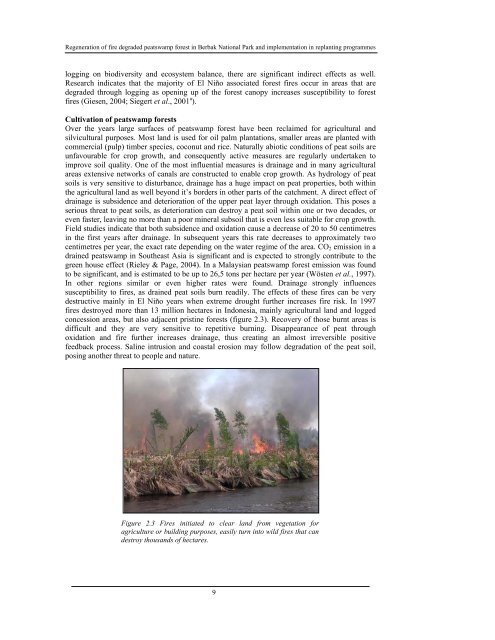Regeneration of fire degraded peatswamp forest in Berbak National ...
Regeneration of fire degraded peatswamp forest in Berbak National ...
Regeneration of fire degraded peatswamp forest in Berbak National ...
You also want an ePaper? Increase the reach of your titles
YUMPU automatically turns print PDFs into web optimized ePapers that Google loves.
<strong>Regeneration</strong> <strong>of</strong> <strong>fire</strong> <strong>degraded</strong> <strong>peatswamp</strong> <strong>forest</strong> <strong>in</strong> <strong>Berbak</strong> <strong>National</strong> Park and implementation <strong>in</strong> replant<strong>in</strong>g programmes<br />
logg<strong>in</strong>g on biodiversity and ecosystem balance, there are significant <strong>in</strong>direct effects as well.<br />
Research <strong>in</strong>dicates that the majority <strong>of</strong> El Niño associated <strong>forest</strong> <strong>fire</strong>s occur <strong>in</strong> areas that are<br />
<strong>degraded</strong> through logg<strong>in</strong>g as open<strong>in</strong>g up <strong>of</strong> the <strong>forest</strong> canopy <strong>in</strong>creases susceptibility to <strong>forest</strong><br />
<strong>fire</strong>s (Giesen, 2004; Siegert et al., 2001 a ).<br />
Cultivation <strong>of</strong> <strong>peatswamp</strong> <strong>forest</strong>s<br />
Over the years large surfaces <strong>of</strong> <strong>peatswamp</strong> <strong>forest</strong> have been reclaimed for agricultural and<br />
silvicultural purposes. Most land is used for oil palm plantations, smaller areas are planted with<br />
commercial (pulp) timber species, coconut and rice. Naturally abiotic conditions <strong>of</strong> peat soils are<br />
unfavourable for crop growth, and consequently active measures are regularly undertaken to<br />
improve soil quality. One <strong>of</strong> the most <strong>in</strong>fluential measures is dra<strong>in</strong>age and <strong>in</strong> many agricultural<br />
areas extensive networks <strong>of</strong> canals are constructed to enable crop growth. As hydrology <strong>of</strong> peat<br />
soils is very sensitive to disturbance, dra<strong>in</strong>age has a huge impact on peat properties, both with<strong>in</strong><br />
the agricultural land as well beyond it’s borders <strong>in</strong> other parts <strong>of</strong> the catchment. A direct effect <strong>of</strong><br />
dra<strong>in</strong>age is subsidence and deterioration <strong>of</strong> the upper peat layer through oxidation. This poses a<br />
serious threat to peat soils, as deterioration can destroy a peat soil with<strong>in</strong> one or two decades, or<br />
even faster, leav<strong>in</strong>g no more than a poor m<strong>in</strong>eral subsoil that is even less suitable for crop growth.<br />
Field studies <strong>in</strong>dicate that both subsidence and oxidation cause a decrease <strong>of</strong> 20 to 50 centimetres<br />
<strong>in</strong> the first years after dra<strong>in</strong>age. In subsequent years this rate decreases to approximately two<br />
centimetres per year, the exact rate depend<strong>in</strong>g on the water regime <strong>of</strong> the area. CO2 emission <strong>in</strong> a<br />
dra<strong>in</strong>ed <strong>peatswamp</strong> <strong>in</strong> Southeast Asia is significant and is expected to strongly contribute to the<br />
green house effect (Rieley & Page, 2004). In a Malaysian <strong>peatswamp</strong> <strong>forest</strong> emission was found<br />
to be significant, and is estimated to be up to 26,5 tons per hectare per year (Wösten et al., 1997).<br />
In other regions similar or even higher rates were found. Dra<strong>in</strong>age strongly <strong>in</strong>fluences<br />
susceptibility to <strong>fire</strong>s, as dra<strong>in</strong>ed peat soils burn readily. The effects <strong>of</strong> these <strong>fire</strong>s can be very<br />
destructive ma<strong>in</strong>ly <strong>in</strong> El Niño years when extreme drought further <strong>in</strong>creases <strong>fire</strong> risk. In 1997<br />
<strong>fire</strong>s destroyed more than 13 million hectares <strong>in</strong> Indonesia, ma<strong>in</strong>ly agricultural land and logged<br />
concession areas, but also adjacent prist<strong>in</strong>e <strong>forest</strong>s (figure 2.3). Recovery <strong>of</strong> those burnt areas is<br />
difficult and they are very sensitive to repetitive burn<strong>in</strong>g. Disappearance <strong>of</strong> peat through<br />
oxidation and <strong>fire</strong> further <strong>in</strong>creases dra<strong>in</strong>age, thus creat<strong>in</strong>g an almost irreversible positive<br />
feedback process. Sal<strong>in</strong>e <strong>in</strong>trusion and coastal erosion may follow degradation <strong>of</strong> the peat soil,<br />
pos<strong>in</strong>g another threat to people and nature.<br />
Figure 2.3 Fires <strong>in</strong>itiated to clear land from vegetation for<br />
agriculture or build<strong>in</strong>g purposes, easily turn <strong>in</strong>to wild <strong>fire</strong>s that can<br />
destroy thousands <strong>of</strong> hectares.<br />
9

















![CynefinFramework final [Read-Only]](https://img.yumpu.com/19017304/1/190x135/cynefinframework-final-read-only.jpg?quality=85)